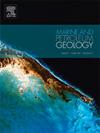峨眉山大火成岩省开江—梁平海槽古环境与有机质富集
IF 3.6
2区 地球科学
Q1 GEOSCIENCES, MULTIDISCIPLINARY
引用次数: 0
摘要
峨眉山大火成岩省(ELIP)对二叠纪环境条件有重要影响。本研究以位于ELIP中心东北方向约800 km的开江和梁平地区中晚二叠世地层为研究对象,结合岩石学和地球化学,探讨ELIP对沉积环境和有机质富集的影响。结果表明,该地层记录保存了ELIP不同发育阶段的喷发产物。开江-梁平海槽在Capitanian晚期至Wuchiapingian期间经历了先隆起后沉降的过程,受构造和火山活动的影响,南北段有机质富集模式存在差异。北部有机质富集于Capitanian晚期谷峰段和吴家坪组上段的硅质泥岩中,南部吴家坪组底部还发育滨海沼泽相页岩。有机质富集受Capitanian晚期高产和缺氧条件的控制,而沉积速率的升高和火山活动引起的陆源输入的增强是Wuchiapingian早期有机质富集的主导因素。五家坪晚期峨眉山长英质火山喷发可能引发了气候降温,促进了上升流恢复和生物恢复,缺氧-缺氧条件和高产能共同控制着有机质富集。这一时期的负δ13Corg偏移可能反映了海平面上升导致陆相有机质输入减少。该研究揭示了火山与沉积过程的时空耦合,为火成岩大省烃源岩的形成提供了新的认识。本文章由计算机程序翻译,如有差异,请以英文原文为准。

Paleoenvironment and organic matter enrichment in the Kaijiang–Liangping Trough across the Emeishan Large Igneous Province (ELIP)
The Emeishan Large Igneous Province (ELIP) substantially influenced Permian environmental conditions. This study focused on Middle–Late Permian strata in the Kaijiang and Liangping regions, located ∼800 km northeast of the ELIP center, integrating petrology and geochemistry to investigate the influence of the ELIP on the sedimentary environment and organic matter enrichment. Results indicate that the stratigraphic records preserve eruptive products from different developmental stages of the ELIP. The Kaijiang–Liangping Trough underwent initial uplift followed by subsidence from the late Capitanian to the Wuchiapingian, with organic enrichment patterns differing between northern and southern sections owing to tectonic and volcanic activity. In the north, organic matter is enriched in the siliceous mudstones of the Gufeng Member in the late Capitanian and the upper Wujiaping Formation of the Wuchiapingian age, whereas the south additionally contains coastal swamp facies shales at the base of the Wujiaping Formation. Organic matter enrichment was controlled by high productivity and anoxic conditions during the late Capitanian, whereas elevated sedimentation rates and enhanced terrigenous input attributable to volcanic activity became dominant factors in the early Wuchiapingian. Late Wuchiapingian Emeishan felsic volcanic eruptions might have triggered climatic cooling, promoting upwelling restoration and biotic recovery, with anoxic–euxinic conditions and high productivity jointly governing organic matter enrichment. The negative δ13Corg excursion during this period might reflect reduced terrestrial organic matter input caused by sea level rise. This study revealed the spatiotemporal coupling of volcanic and sedimentary processes, offering new insights into hydrocarbon source rock formation in large igneous provinces.
求助全文
通过发布文献求助,成功后即可免费获取论文全文。
去求助
来源期刊

Marine and Petroleum Geology
地学-地球科学综合
CiteScore
8.80
自引率
14.30%
发文量
475
审稿时长
63 days
期刊介绍:
Marine and Petroleum Geology is the pre-eminent international forum for the exchange of multidisciplinary concepts, interpretations and techniques for all concerned with marine and petroleum geology in industry, government and academia. Rapid bimonthly publication allows early communications of papers or short communications to the geoscience community.
Marine and Petroleum Geology is essential reading for geologists, geophysicists and explorationists in industry, government and academia working in the following areas: marine geology; basin analysis and evaluation; organic geochemistry; reserve/resource estimation; seismic stratigraphy; thermal models of basic evolution; sedimentary geology; continental margins; geophysical interpretation; structural geology/tectonics; formation evaluation techniques; well logging.
 求助内容:
求助内容: 应助结果提醒方式:
应助结果提醒方式:


